Dates 24 Jul 1779 – 12 Aug 1779 | Result British victory | |
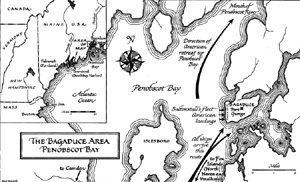 | ||
700 regulars10 warships 1,000+ militiaContinental Marines19 warships25 support ships 25 killed35 wounded26 captured 474 killed, wounded, captured or missingAll ships lost Similar American Revolutionary War, Battle of Rhode Island, Battle of Machias, Grey's raid, Burning of Falmouth | ||
Home the story of maine the penobscot expedition and the revolution
The Penobscot Expedition was a 44-ship American naval task force mounted during the Revolutionary War by the Provincial Congress of the Province of Massachusetts Bay. The flotilla of 19 warships and 25 smaller support vessels sailed from Boston on July 19, 1779 for the upper Penobscot Bay in the District of Maine carrying a ground expeditionary force of more than 1,000 colonial Marines and militiamen. Also included was a 100-man artillery detachment under the command of Lt. Colonel Paul Revere. The Expedition's goal was to reclaim control of what is now mid-coast Maine from the British who had seized it a month earlier and renamed it New Ireland. It was the largest American naval expedition of the war. The fighting took place both on land and at sea in and around the mouth of the Penobscot and Bagaduce Rivers at what is today Castine, Maine over a period of three weeks in July and August of 1779. One of its greatest victories of the war for the British, the Expedition was also the United States' worst naval defeat until Pearl Harbor 162 years later in 1941.
Contents
- Home the story of maine the penobscot expedition and the revolution
- C span cities tour augusta the penobscot expedition
- Background
- British forces arrive
- American reaction
- Landing
- Assault
- Siege
- Casualties
- Aftermath
- Legacy
- In popular culture
- References
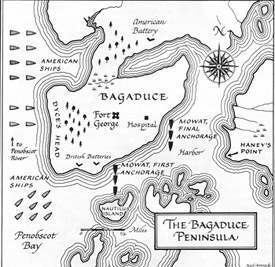
On June 17 of that year, British Army forces under the command of General Francis McLean landed and began to establish a series of fortifications centered on Fort George, located on the Majabigwaduce Peninsula in the upper Penobscot Bay, with the goals of establishing a military presence on that part of the coast and establishing the colony of New Ireland. In response, the Province of Massachusetts, with some support from the Continental Congress, raised an expedition to drive the British out.

The Americans landed troops in late July and attempted to establish a siege of Fort George in a series of actions that were seriously hampered by disagreements over control of the expedition between land forces commander Brigadier General Solomon Lovell and the expedition's overall commander, Commodore Dudley Saltonstall, who was subsequently dismissed from the Navy for ineptness and failure to effectively prosecute the mission. For almost three weeks General McLean held off the assault until a British relief fleet under the command of Sir George Collier arrived from New York on August 13, driving the American fleet to total self-destruction up the Penobscot River. The survivors of the American expedition were forced to make an overland journey back to more populated parts of Massachusetts with minimal food and armament.
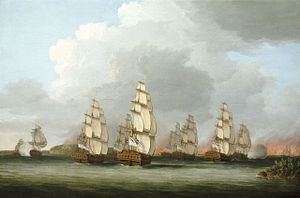
C span cities tour augusta the penobscot expedition
Background
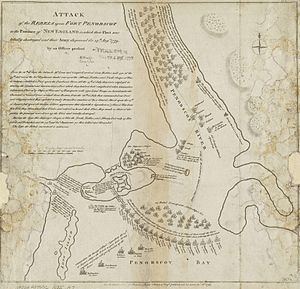
Following the partially successful raid of Machias in 1777, as well as General John Burgoyne's failed Saratoga campaign, British war planners looked for other ways to gain control over the rebellious New England colonies, while most of their effort was directed at another campaign targeted at the southern colonies. Secretary of State for the Colonies Lord George Germain, the 1st Viscount Sackville, and his Under-Secretary, William Knox, as those responsible for the war effort wanted to establish a base on the coast of the District of Maine (which until achieving statehood in 1820 was a part of Massachusetts) that could be used to protect Nova Scotia's shipping and communities from American privateers and raiders.

Among the specific reasons for the British to undertake such an occupation were: to keep open the timber supply of the Maine coast for masts and spars for the Royal Navy; that the Maine coast down to the Penobscot was immediately adjacent to the Bay of Fundy which was easily approached from the large British naval base at Halifax, and; because Loyalist refugees in Castine had proposed the establishment of a new colony or province to be called New Ireland as a precursor to the establishment of Loyalist New Brunswick in 1784. That last reason was strongly supported by Sir Francis Bernard, the former Governor of the Massachusetts Bay Colony then living back in London, who said it would make "a resort for the persecuted loyalists of New England."
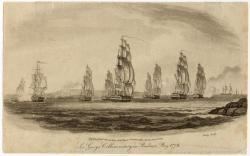
In order to promote the idea of establishing a British military presence in Maine, in January 1778 Knox induced John Nutting, a Loyalist who had piloted Sir George Collier's expedition against Machias, to write to Lord Germain and later dispatched him to London to do so in person. In doing so Nutting described the Castine peninsula as having a harbor that "could hold the entire British Navy" and was so easily defendable that "1,000 men and two ships" could protect it against any Continental force. He also proposed that the strategic location of such a post would help carry the war to New England as well as offer protection for Nova Scotia from attack. Although Admiral Collier asked Nutting a year later what could possibly have induced him to recommend a settlement there (which he then denied), in light of subsequent events Nutting's figures for defense at Castine proved to be amazingly accurate.
On September 2, 1778, Lord Germain drafted orders for Lieutenant General Sir Henry Clinton, commander-in-chief of British forces in North America (which the Colonial Office tasked Nutting to carry to New York) to assist with the establishment of "a province between the Penobscot and St. Croix rivers. Post to be taken on Penobscot River." Germain's orders to Clinton read in part:
"The distress of the King's loyal American subjects who have been driven from their habitations and deprived of their property by the rebels has been an object of attention with His Majesty and Parliament from the first appearance of the rebellion; and very considerable sums have been expended in furnishing them with a temporary support. But, as their number is daily increasing and is much to be apprehended (if a reconciliation does not soon take place) that scarcely any who retain their principles will be suffered to remain in the revolted provinces, it is judged proper in that event that a permanent provision should be made by which they may be enabled to support themselves and their families without being a continual burden upon the revenue of Great Britain.
"The tract of country that lies between Penobscot River and the River St. Croix, the boundary of Nova Scotia on that side, offers itself for the reception of those meritorious but distressed people. And it is the King's intention to erect it into a province. As the first step toward making this establishment it is His Majesty's pleasure, if peace has not taken place and the season of the year is not too far advanced before you receive this, that you do send such a detachment of troops at Nova Scotia, or of the provincials under your immediate command, as you shall judge proper and sufficient to defend themselves against any attempt the rebels in those parts may be able to make during the winter to take post on Penobscot River, taking with them all necessary implements for erecting a fort, together with such ordnance and stores as may be proper for its defense, and a sufficient supply of provisions."
It was Knox's idea to call this province New Ireland. Unfortunately for the British, Nutting's ship was captured by an American privateer, and he was forced to dump his dispatches, putting an end to execution of the idea in 1778.
British forces arrive
Nutting reached New York in January 1779, but General Clinton had received copies of the orders from other messengers. Clinton had already assigned the expedition to General Francis McLean who was based in Halifax and thus sent Nutting there with Germain's detailed instructions.
McLean's expedition set sail from Halifax on May 30, 1779, and arrived in the Penobscot Bay on June 12. The next day McLean and Captain Andrew Barkley, the commander of the naval convoy, identified a suitable site at which they could establish a post. On June 16, his forces began landing on a peninsula that was then called Majabigwaduce (now Castine), between the mouth of the Bagaduce River and a finger of the bay leading to the Penobscot River. The troops numbered approximately 700: 50 men of the Royal Artillery and Engineers, 450 of the 74th Regiment of (Highland) Foot and 200 of the 82nd (Duke of Hamilton's) Regiment. These began to build a fortification on the peninsula, which jutted into the bay and commanded the principal passage into the inner harbor.
Fort George was established in the center of the small peninsula with two batteries outside the fort to provide cover for the Albany, which was the only ship expected to stay in the area. A third battery was constructed on an island south of the bay in which the Albany was harbored, near the mouth of the Bagaduce River. Construction of the works occupied the troops for the next month, until rumors came that an American expedition was being raised in Boston to oppose them, following which efforts were redoubled to have works suitable for defense against the Americans prepared before they arrived. Captain Henry Mowat of the Albany, who was familiar with Massachusetts politics, took the rumors (which were followed by reports that a fleet had left Boston) quite seriously, and convinced General McLean to leave additional ships that had been part of the initial convoy as further defense. Some of the convoy ships had already left; orders for armed sloops North and Nautilus were countermanded before they were able to leave.
American reaction
When news of this reached the American authorities at Boston, they hurriedly made plans to drive the British from the area. The Penobscot River was the gateway to lands controlled by the Penobscot Indians who generally favored the British. Congress feared that if a fort were successfully constructed at the mouth of the river, all chance of enlisting the Penobscots as allies would be lost. Massachusetts was also motivated by the fear of losing their claim over the territory to rival states in any post-war settlement.
To spearhead the expedition, Massachusetts petitioned Congress for the use of three Continental Navy warships—the 12-gun sloop Providence, 14-gun brig Diligent, and 32-gun frigate Warren—while the rest of over 40 vessels were made up of both ships of the Massachusetts State Navy and private vessels under the command of Commodore Dudley Saltonstall. The Massachusetts authorities mobilized more than 1,000 militia, acquired six small field cannons, and placed Brigadier General Solomon Lovell in command of the land forces. The expedition departed from Boston harbor on July 19 and arrived off Penobscot six days later on the afternoon of July 25.
Landing
On July 25, nine of the larger vessels in the American flotilla exchanged fire with the Royal Navy ships from 3.30 p.m. to 7.00 p.m. While this was going on, seven American boats approached the shore for a landing but turned back when enemy fire killed an American-allied Native warrior in one of the boats. On July 26, Lovell sent a force of Continental Marines to capture the British battery on Nautilus Island (also known as Banks Island), while the militia were to land at Bagaduce. The marines achieved their objective but the militia turned back when British shot overturned the leading boat, drowning Major Daniel Littlefield and two of his men. Meanwhile, 750 men under Lovell landed and began construction of siege works under constant fire. On July 27, the American artillery bombarded the British fleet for three hours, wounding four men aboard HMS Albany.
Assault
On July 28, under heavy covering fire from the Tyrannicide, Hunter, and Sky Rocket, Brigadier General Peleg Wadsworth led an assault force of 400 (200 marines and 200 militia) ashore before dawn at Dyce's Head on the western tip of the peninsula with orders to capture Fort George. They landed on the narrow beach and advanced up the steep bluff leading to the fort. The British pickets, who included Lieutenant John Moore, put up a determined resistance but received no reinforcement from the fort and were forced to retire, leaving the Americans in possession of the heights. Eight British troops were captured. At this point, Lovell ordered the attackers to halt and entrench where they were. Instead of assaulting the fort, Lovell had decided to build a battery within "a hundred rods" of the British lines and bombard them into surrender. The American casualties in the assault had been severe: "one hundred out of four hundred men on the shore and bank", with the Continental Marines suffering more heavily than the militia. Commodore Saltonstall was so appalled by the losses incurred by his marines that he refused to land any more and even threatened to recall those already on shore. In addition his flagship, the Continental frigate Warren, suffered considerable damage during the engagement with hits to its mainmast, forestay and gammoning.
Although possessing significant naval superiority over the British, over the next two weeks the excessively cautious Saltonstall dawdled despite the repeated requests by General Lovell that he attack Mowatt's position at the entrance to the harbor. Instead he largely maneuvered the American fleet around the mouth of the Penobscot River beyond the range of the British guns with only occasional ineffective attempts to engage the British. As long as the British warships continued to hold the harbor they were able to pin down the American forces on the ground with concentrated fire and prevent them from taking Fort George.
Realizing that time was running out, on August 11 General Lovell again wrote to Saltonstall pleading for him to attack saying: "I mean not to determine on your mode of attack; but it appears to me so very practicable, that any farther delay must be infamous; and I have it this moment by a deserter from one of their ships, that the moment you enter the harbour they will destroy them." Saltonstall's ineptitude at Penobscot would lead to his being dismissed from the Navy as being "ever after incompetent to hold a government office or state post" the following October by the "Committee for Enquiring into the Failure of the Penobscot Expedition" of the Massachusetts General Court which determined that failure of the expedition was primarily the result of the "want of proper Spirit and Energy on the part of the Commodore", that he "discouraged any Enterprizes or offensive Measures on the part of our Fleet", and that the total destruction of the fleet was occasioned "principally by the Commodore's not exerting himself at all at the time of the Retreat in opposing the Enemies' foremost Ships in pursuit."
Siege
On July 29, one American was killed. July 30, both sides cannonaded each other all day, and on July 31 two American sailors belonging to the Active were wounded by a shell. Lovell ordered a night assault on August 1 against the Half-Moon Battery located next to Fort George, the guns of which posed a danger to the American shipping and the Americans opened fire at 2.00 a.m. Colonel Samuel McCobb's center column, comprising his own Lincoln County Regiment, broke and fled as soon as the British returned fire. The left column comprising Captain Thomas Carnes and a detachment of marines, and the right column comprising sailors from the fleet, both kept going and stormed the battery. As dawn broke, the Fort’s guns opened up on the captured battery and a detachment of redcoats charged out and recaptured the Half-Moon, routing the Americans and taking 18 prisoners with them. Their own casualties were four men missing (who were killed), and 12 wounded.
The siege continued with minor skirmishing on August 2 with militiaman Wheeler Riggs of Falmouth being killed by an enemy cannon shot that bounced off a tree before hitting him. On August 4 Surgeon John Calef recorded in his journal that several men were wounded in exchanges of fire. On August 5 one American-allied Indian was killed and another man captured, and on August 7, 100 Americans engaged 80 British with one killed and one wounded on the American side and two wounded among the British.
During this time, the British had been able to send word of their condition, and request reinforcements and on August 3 Captain (later Vice Admiral) Sir George Collier led a fleet of ten warships out of New York.
On August 11, about 250 American militia advanced from their fortified camp and occupied a recently abandoned battery about a quarter mile (400 meters) from the British fort. As expected, a sortie of about 55 British troops advanced from the fort to engage but the poorly trained American troops fired only one volley at the attacking British troops, inflicting about 13 casualties, and fled back to their fort, leaving behind all of their arms and equipment.
The next day, Saltonstall finally decided to launch a naval attack against the British fort, but Collier's British relief fleet arrived and attacked the American ships. Over the next two days, the American fleet fled upstream on the Penobscot River pursued by Collier. On August 13, an American officer was wounded by enemy fire. On August 13 and 14 many of the vessels were either captured by Collier or scuttled and burned by their own crews while the rest were destroyed at Bangor. In the 18th century there were rapids at Bangor at the approximate location of the old Water Works. The surviving crews then fled overland back to Boston with virtually no food or ammunition.
Casualties
Over the course of the siege, Colonel David Stewart claims the British garrison suffered 25 killed and 34 wounded. Stewart gives no figures for captured or missing but 26 prisoners are known to have been taken by the Americans.
Apart from the 100 men killed and wounded during the assault of July 28, the known American casualties throughout the siege came to 12 killed, 16 wounded and one captured, in addition to "several wounded" on August 4. This adds up to at least 130 killed and wounded. The History of Penobscot says that "our whole loss of men was probably not less than 150". The chaotic retreat however, brought the American loss up to 474 killed, wounded, captured or missing.
Aftermath
A committee of inquiry blamed the American failure on poor coordination between land and sea forces and on Commodore Saltonstall's failure to engage the British naval forces. On September 7, 1779, a Warrant for Court Martial was issued by the Navy Board, Eastern Department, against Saltonstall. Upon trial he was declared to be primarily responsible for the debacle, found guilty, and dismissed from military service. Paul Revere, who commanded the artillery in the expedition, was accused of disobedience and cowardice. This resulted in his dismissal from the militia, even though he was later cleared of the charges. Peleg Wadsworth, who mitigated the damage by organizing a retreat, was not charged in the court martial.
A year later the British Cabinet formally approved the New Ireland project on August 10, 1780, and King George III gave his assent the following day to the proposal to separate “the country lying to the northeast of the Piscataway [Piscataqua] River” from the province of Massachusetts Bay in order to establish “so much of it as lies between the Sawkno [Saco] River and the St. Croix, which is the southeast [sic] boundary of Nova Scotia into a new province, which from its situation between the New England province and Nova Scotia, may with great propriety be called New Ireland.” Pursuant to the terms of the 1783 Peace of Paris all British forces then evacuated Fort George (followed by some 600 Loyalists who removed from the area to St. Andrews on Passamaquoddy Bay) and abandoned their attempts to establish New Ireland. During the War of 1812, however, British forces again occupied Fort George (still calling the area New Ireland) from September 1814 to April 1815 and used it as a naval base before withdrawing again with the arrival of peace. Full ownership of present-day Maine (principally the northeastern borders with New Brunswick) remained disputed until the Webster-Ashburton Treaty in 1842. The "District of Maine" was a part of Massachusetts until 1820 when it was admitted into the Union as the 23rd state as part of the Missouri Compromise.
Legacy
In 1972 the Maine Maritime Academy and the Massachusetts Institute of Technology searched for and found the wreck of the Defence, a privateer that was part of the American fleet. Evidence of scuttled ships was also found under the Joshua Chamberlain Bridge in Bangor and under the Bangor town dock, and several artifacts were recovered. Cannonballs were also reported to have been recovered during the construction of the concrete casements for the I-395 bridge in 1986.
The earthworks of Fort George still stand at the mouth of the Penobscot River in Castine, accompanied by concrete work added later by the Americans in the 19th century. Archaeological evidence of the expedition, including cannonballs and cannon, was located during an archaeological project in 2000–2001.
In popular culture
Bernard Cornwall's historical novel The Fort gives an account of the expedition. It draws attention to the presence there of a junior British officer named John Moore, later a famous general.
